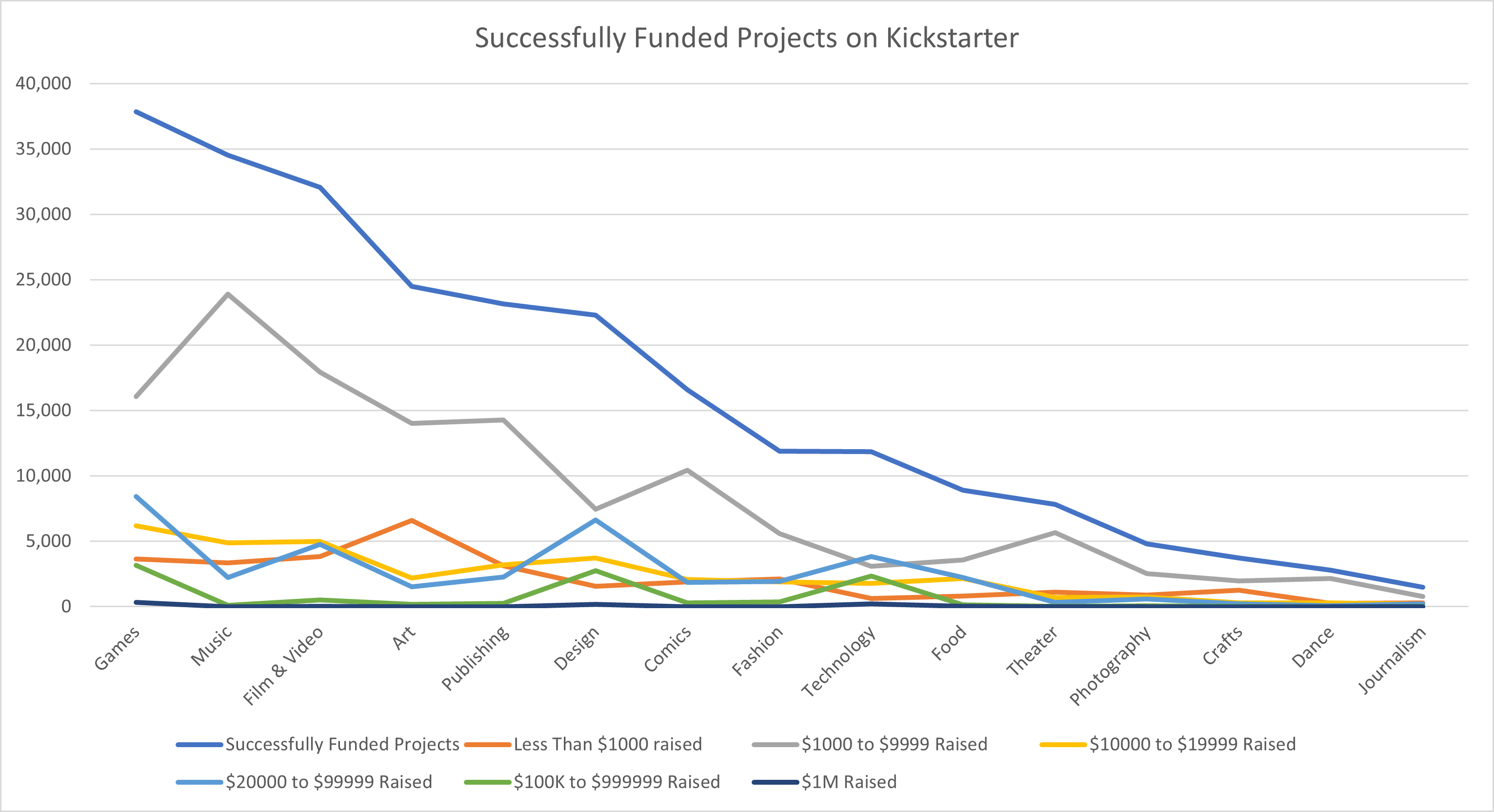The Ultimate Kickstarter Promotion Guide will cover several aspects of the Kickstarter platform, so that you can follow the norms to successfully publish your Kickstarter campaign. Launching a Kickstarter campaign is an exhilarating journey filled with creative passion and entrepreneurial spirit. However, a successful Kickstarter campaign is not just about having a great idea – it requires effective promotion and marketing to reach your funding goals.

Table of Contents
Introduction
Kickstarter is a crowdfunding platform that allows individuals, businesses, and creative projects to raise funds for their ideas, products, or ventures. It was founded in 2009 and has since become one of the most popular and well-known crowdfunding websites. In this comprehensive guide, we’ll delve into the strategies and tactics that can help you maximize your Kickstarter campaign’s visibility and increase your chances of turning your dream project into a fully funded reality.
Why Kickstarter?
Kickstarter is a popular crowdfunding platform that has gained significant recognition and support from creators, backers, and the creative community for various reasons. Here are some key reasons why creators choose Kickstarter:
- Access to Funding: Kickstarter provides a platform for creators to secure funding for their projects without relying solely on traditional financing methods. In addition, It allows individuals or small teams with innovative ideas to access financial support from a global community.
- Creative Freedom: Kickstarter empowers creators to bring their unique and creative visions to life. Therefore, it’s a space where projects that might not fit within traditional funding models can find support.
- Validation and Feedback: Launching a Kickstarter campaign can help creators validate their ideas before investing significant time and resources. Hence, backer engagement and feedback during the campaign provide valuable insights for refining and improving the project.
- Community Building: Kickstarter fosters a sense of community and connection between creators and backers. Backers become invested in the success of the project, often forming long-lasting relationships with the creators.
- Marketing and Exposure: Kickstarter provides a built-in platform for showcasing your project to a wide audience. Therefore, campaigns can gain exposure through Kickstarter’s website, search features, and trending sections, potentially attracting media attention as well.
- Pre-Sales and Market Testing: Kickstarter campaigns can serve as a form of pre-sales, allowing creators to gauge demand for their product or idea. It’s a way to test the market before producing a large quantity.
- Funding without Debt or Equity: Unlike traditional investment or loan-based funding, Kickstarter backers don’t receive equity in the project or expect repayment with interest. This can therefore be appealing for creators who want to maintain full ownership and control of their project.
- Flexible Funding Goals: Kickstarter offers both all-or-nothing and flexible funding options. In addition, creators can choose the funding model that aligns with their project’s needs and risk tolerance.
- Platform Expertise: Kickstarter has a track record of successful campaigns and provides resources, guides, and tools to help creators launch effective campaigns. Also, it’s a supportive environment for both newcomers and experienced entrepreneurs.
- Diverse Range of Projects: Kickstarter hosts campaigns spanning various industries, from technology and design to arts, music, film, and more. Hence, this diversity attracts backers interested in supporting a wide array of creative endeavors.
- Global Reach: Kickstarter’s online platform allows creators to reach a global audience, breaking down geographical barriers and enabling projects to connect with backers from around the world.
- Crowdsourced Marketing: Successful Kickstarter campaigns often benefit from organic word-of-mouth marketing as backers share the projects they support with their networks.
- Funding for Passion Projects: Kickstarter allows creators to pursue passion projects that might not have immediate commercial viability. Backers who thereby share the same passion are more likely to support such endeavors.
While Kickstarter offers numerous benefits, it’s important to recognize that running a successful campaign requires careful planning, dedication, and effective marketing. In addition, not all projects achieve their funding goals, but for those that do, Kickstarter can be a transformative platform that turns creative dreams into reality.
Kickstarter Stats in a Nutshell
As of August 2023, here are some key statistics related to Kickstarter. However, please note that these numbers may change after the publishing of this guide, so it’s a good idea to refer to the official Kickstarter website or recent industry reports for the most up-to-date information.
- Total Projects Launched: Over 601147 projects have been launched on Kickstarter since its inception in 2009.
- Total Pledges: Kickstarter has received over $7.5 billion in pledges from backers.
- Total Backers: Kickstarter has had more than 22.3 million backers supporting various projects.
- Success Rate: The overall success rate of Kickstarter projects is around 40.8%. Therefore, this means that approximately 40% of projects launched on the platform successfully reach their funding goals.
- Total Categories: Kickstarter hosts projects in a wide range of categories, including technology, design, art, music, film, food, games, publishing, and more.
- Most Funded Project: As of August 2023, the most funded project on Kickstarter was the Pebble Time smartwatch, which raised over $20.34 million.
- Average Pledge Amount: The average pledge amount per backer is around $25-$50.
- Top Backer Countries: The United States is the largest contributor to Kickstarter campaigns, followed by the United Kingdom and Canada.
- Most Active Months: Kickstarter campaigns tend to see higher activity during the months of March, April, and May, with more projects launching and receiving pledges.
- Peak Funding Time: The most common time of day for backers to make pledges is around 1-2 PM EST.
- Top Categories by Funding: The categories that receive the most funding on Kickstarter includes technology, games, design, and film.
- Gender Distribution: Kickstarter’s backer community is fairly balanced in terms of gender, with both male and female backers participating actively.
- Location Distribution: Kickstarter projects have been launched from over 225 countries and territories.
It’s important to remember that Kickstarter’s statistics can vary over time and across different projects. Moreover, while these statistics provide a general overview, individual campaign outcomes can differ based on factors such as project quality, marketing efforts, target audience, and project category. For the most current and accurate data, consider visiting Kickstarter’s official website or referring to recent industry reports.
Here is an overview of the successfully funded projects on Kickstarter, as of August 2023:

The Do’s of Kickstarter Campaigns
Pre-launch Preparation: Set the Stage for Success
Before hitting the launch button, lay the groundwork for your campaign’s success:
- Build a Strong Online Presence: Establish a captivating website or landing page that introduces your project, its benefits, and your story. In addition, use high-quality visuals and engaging content to capture visitors’ attention.
- Social Media Engagement: Create accounts on major social media platforms relevant to your target audience. Start teasing your project, sharing behind-the-scenes content, and interacting with potential backers.
- Email List Building: Collect email addresses from interested parties before launch. Moreover, use incentives like exclusive updates or early-bird offers to encourage sign-ups.
- Influencer Outreach: Identify influencers, bloggers, or YouTubers in your niche. Therefore, reach out to them with a compelling pitch about your project and how it aligns with their audience’s interests.
Crafting an Irresistible Campaign Page
Your Kickstarter campaign page is your digital storefront. Make it compelling and informative:
- Compelling Storytelling: Craft a compelling project narrative that resonates with potential backers emotionally. Hence, share your journey, challenges, and inspirations behind the project.
- High-Quality Images and Graphics: Use high-resolution images that showcase your product from various angles. Visuals should therefore convey the quality and uniqueness of your project. Here’s an example of a Kickstarter Presentation Video
- Rewards Tiers: Develop enticing reward tiers that offer backers value for their support. Ensure the rewards are attractive, well-defined, and relevant to your project.
Launch and Early Momentum
The first few days of your campaign are crucial for building momentum:
- Launch with Impact: Choose a launch date that allows you to give your campaign full attention. In addition, aim for a strong start by promoting your campaign across all your prepared channels simultaneously.
- Backer Engagement: Engage with backers promptly. Most importantly, respond to comments, messages, and inquiries with enthusiasm and professionalism. Backer engagement can encourage others to pledge.
- Limited-Time Offers: Introduce early-bird discounts or limited-time rewards to incentivize early backers and create a sense of urgency.
Marketing Outreach
Effective marketing strategies can expand your campaign’s reach:
- Social Media Marketing: Continue to leverage your social media presence. Share updates, milestones, and user-generated content to maintain excitement.
- Press Releases and Media Coverage: Draft a compelling press release and pitch it to relevant media outlets, blogs, and online magazines. Moreover, positive media coverage can significantly boost your campaign’s visibility.
- Collaborations and Partnerships: Partner with complementary projects, brands, or influencers for cross-promotion. This can therefore introduce your campaign to a wider audience.
- Paid Advertising: Consider using platforms like Facebook Ads, Instagram Ads, or Google Ads to target your specific audience. And also, tailor your ads with attention-grabbing visuals and persuasive copy.
Mid-Campaign Boost and Stretch Goals
Keep the momentum going during the middle phase of your campaign:
- Introduce Stretch Goals: Offer additional rewards or project enhancements as you reach funding milestones. In addition, stretch goals can reignite interest and encourage backers to spread the word.
- Backer-Generated Content: Encourage backers to create and share content related to your project. User-generated content can serve as powerful testimonials and endorsements.
Final Push and Closing Strategy
As your campaign nears its end, create a sense of urgency:
- Countdowns and Reminders: Highlight the remaining days of the campaign and remind potential backers about the opportunity to support your project.
- Last-Minute Rewards: Introduce exclusive last-minute rewards or discounts to encourage fence-sitters to pledge before time runs out.
- Thank Your Backers: Express gratitude to your backers through personalized messages or updates. Moreover, a sincere thank-you can foster a loyal community for future projects.
The Don’ts of Kickstarter Campaign
Absolutely, there are several common pitfalls and mistakes that creators should avoid when launching a Kickstarter campaign. Here are some things to steer clear of:
- Lack of Planning and Preparation: Rushing into a Kickstarter campaign without thorough planning can lead to a lackluster launch. Therefore, make sure you have a clear project plan, budget, and timeline in place before going live.
- Unrealistic Funding Goals: Setting overly ambitious funding goals that are not attainable can discourage potential backers. Your funding goal should be realistic and cover essential expenses.
- Insufficient Research: Failing to research and understand your target audience, market trends, and competition can hinder your campaign’s success. Know who your backers are and what they want.
- Poor Campaign Presentation: A cluttered or confusing campaign page can turn potential backers away. Ensure your campaign page is well-designed, easy to navigate, and visually appealing.
- Weak Storytelling: Your project’s story is a crucial factor in connecting with backers emotionally. Avoid presenting a bland or uninspiring narrative. Use storytelling to convey your passion and the project’s significance.
- Low-Quality Visuals: Blurry images, poorly designed graphics, or a lack of visual content can give an unprofessional impression. High-quality visuals are therefore essential to showcase your project’s value.
- Overwhelming Technical Jargon: Keep your campaign messaging simple and easy to understand. Hence, avoid using excessive technical jargon that might alienate potential backers.
- Ignoring Backer Engagement: Neglecting to respond to backer comments, questions, and messages can lead to a negative perception. Engage with your backers promptly and professionally.
- Lack of Updates: Regular updates keep backers engaged and informed about the campaign’s progress. A lack of updates might make backers lose interest or trust in your project.
- Unrealistic Rewards: Offering rewards that are impractical to fulfill or have inflated value can lead to logistical challenges and disappoint backers.
- Overcomplicating Rewards: Keep reward tiers simple and easy to understand. Too many options can confuse backers and make their decision-making process difficult.
- Poorly Defined Stretch Goals: If you introduce stretch goals, ensure they enhance the project and provide meaningful value to backers. Vague or irrelevant stretch goals can undermine your campaign.
- Ignoring Marketing and Promotion: Relying solely on Kickstarter’s built-in audience is a mistake. Moreover, you need to actively promote your campaign through various channels to maximize its reach.
- Lack of Social Proof: Backer testimonials, reviews, or endorsements from influencers can provide social proof and credibility. Ignoring these elements can weaken your campaign’s legitimacy.
- Failure to Deliver on Promises: One of the most damaging mistakes is not delivering rewards as promised. Make sure you can fulfill your commitments to backers before launching.
- Disregarding Legal and Tax Implications: Kickstarter campaigns can have legal and tax implications. Therefore, failing to address these aspects can lead to complications down the line.
- Ignoring Analytics and Data: Monitoring campaign analytics can help you understand what’s working and what’s not. Ignoring data can prevent you from making necessary adjustments.
By avoiding these common pitfalls, you can enhance the chances of your Kickstarter campaign’s success and create a positive experience for both you and your backers.
Kickstarter Alternatives
Certainly, there are several alternative crowdfunding platforms to Kickstarter, each with its own unique features and focus. Here are some popular Kickstarter alternatives that creators can consider:
- Indiegogo: Similar to Kickstarter, Indiegogo allows creators to launch crowdfunding campaigns for a wide range of projects. It offers both fixed funding and flexible funding options, giving creators more flexibility in their campaign goals.
- GoFundMe: While often associated with personal fundraising, GoFundMe can also be used for creative projects, charitable causes, and business ventures. It offers a flexible funding model where creators keep whatever funds they raise, even if they don’t reach their goal.
- Patreon: Unlike traditional crowdfunding, Patreon is focused on ongoing support for creators. Backers pledge a recurring payment to support creators’ ongoing work, such as artists, musicians, writers, and podcasters.
- Crowdfunder: Crowdfunder is geared towards equity crowdfunding, allowing businesses to raise funds by offering equity or debt to investors. It’s more suitable for startups and established businesses seeking investment.
- Seedrs: Another platform focused on equity crowdfunding, Seedrs connects startups and investors. It’s a regulated platform that allows businesses to raise capital by offering shares to investors.
- Fundable: Fundable is a crowdfunding platform specifically designed for businesses and startups. It offers both rewards-based and equity-based crowdfunding options.
- RocketHub: RocketHub offers crowdfunding for creative projects, innovations, and startups. It emphasizes community support and offers a variety of funding options, including rewards-based and equity-based campaigns.
- KICKICO: KICKICO combines blockchain technology with crowdfunding, allowing creators to launch campaigns and offer tokens or cryptocurrency rewards to backers.
- Ulule: Ulule is a crowdfunding platform with a strong focus on creative projects, social impact, and innovation. It’s popular in Europe and offers both fixed and flexible funding options.
- Crowdcube: Crowdcube is a UK-based equity crowdfunding platform that connects startups and growing businesses with investors who can purchase shares in the company.
- StartEngine: StartEngine is an equity crowdfunding platform that allows businesses to raise capital by selling shares to the general public.
- YouCaring (Now Part of GoFundMe): Formerly an independent platform, YouCaring was known for its focus on compassionate and charitable causes, including medical expenses, community projects, and creative endeavors.
- Experiment: Experiment focuses on scientific and research projects, allowing researchers to raise funds for their studies and experiments.
It’s important to research and evaluate each platform to determine which one aligns best with your project’s goals, target audience, and funding needs. Each platform has its own fee structures, guidelines, and audience demographics, so choosing the right one can significantly impact the success of your crowdfunding campaign.
Conclusion
Launching a successful Kickstarter campaign requires more than just a great idea; it demands a strategic and proactive approach to promotion. By following this comprehensive Kickstarter promotion guide, you’ll be better equipped to navigate the challenging waters of crowdfunding and increase your chances of transforming your creative vision into a fully funded reality. Remember, every action you take, from pre-launch preparation to the final push, contributes to the overall success of your campaign. So, go ahead and embark on this exciting journey, armed with the knowledge and strategies you’ve gained here. Your dream project is one step closer to becoming a triumphant reality.
Recent Posts
Recap 2024: Top 10 Social Media Ad Campaigns by Small Businesses
Social media is an equalizer for small businesses, enabling them to reach large audiences with[...]
How AI is Going to Shape the Future of Advertising in 2025
In the fast-evolving landscape of advertising, Artificial Intelligence (AI) is no longer just a[...]
Why Video Ads Convert Faster Than Image Ads
In the ever-evolving world of digital marketing, brands constantly search for ways to stand[...]



